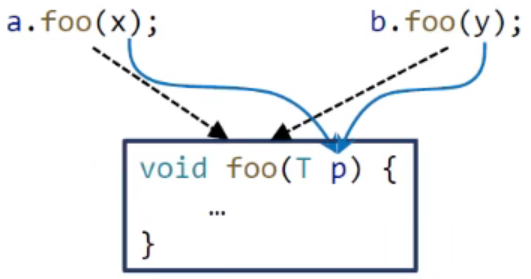static_program_analysis_06_pointer_analysis
Pointer Analysis
Contents
- Motivation
- Introduction to Pointer Analysis
- Key Factors of Pointer Analysis
- Concerned Statements
Motivation
via CHA
void foo(){ |
存在如上的示例代码,如果用CHA,那么n.get()根据Number类,会得到的target method是:{Zero.get(), One.get(), Two.get()};
根据常量传播的分析,x=NAC,因为0,1,2三个值都返回,merge时则为NAC;
因此在这种情况中,使用CHA的常量传播算法就丢失了精度;
如果用指针分析来分析程序呢?
via Pointer Analysis
void foo(){ |
简单来说,由于n.get()的调用,根据指向的对象One,因此可以精确地得到target method:{One.get()};
因此可以准确地到返回值1;
Introduction to Pointer Analysis
- A fundamental static analysis
- Computes which memory locations a pointer can point to - 计算指针指向内存的位置
- For object-oriented programs(focus on Java)
- Computes which objects a pointer(variable or field) can point to - 计算指针指向的对象
- Regarded as a may-analysis
- Computes an over-approximation of the set of objects that a pointer can point to, i.e., we ask “a pointer may point to which objects?” - 指针指向了哪些对象
Example
// Sample 2 |
存在以上程序,通过指针分析,输入上面的程序,得到对应的表格:
| Variable | Object |
|---|---|
| a | new A |
| x | new B |
| this | new A |
| b | new B |
| y | new B |
| Field | Object |
|---|---|
| new A.b | new B |
那么如何通过程序来得到这样的表格呢?
Alias Analysis
这里引出了一种分析–Alias analysis
Two closely related but different concepts
- Pointer analysis: which objects a pointer can point to?
- Alias anlaysis: can two pointers point to the same object?
If two pointers, say p and q, refer to the same object, then p and q are aliases
p = new C(); |
上面的例子可以得出,p和q是aliases,而x和y则不是;
Applications of Pointer Analysis
- Fundamental information
- Call graph
- aliases
- …
- Compiler optimization
- Virtual call inlining
- …
- Bug detection
- Null pointer detection
- …
- Security anlaysis
- Information flow analysis
- …
- And many more…
Key Factors of Pointer Analysis
- Pointer analysis is a complex system
- Multiple factors affect the precision and efficiency of the system
| Factor | Problem | Choice |
|---|---|---|
| Heap abstarction | How to model heap memory? | - Allocation-site - Storeless |
| Context sensitivity | How to model calling contexts? | - Context-sensitive - Context-insensitive |
| Flow sensitivity | How to model control flow? | - Flow-sensitive - Flow-insensitive |
| Analysis scope | Which parts of program should be are analyzed? | - Whole-program Demand-driven |
Heap Abstraction
How to model heap memory?
-
In dynamic execution, the number of heap objects can be unbounded due to loops and recursion
for (...){
A a = new A();
} -
To ensure termination, heap abstraction models dynamically allocated, unbounded concrete objects as finite abstract objects for static analysis

为了确保循环或者其他原因产生无穷尽的内存堆块(这样就不好进行静态分析),使用抽象的方法将具有共性的对象抽象到一起,形成有限的处理单元,保证静态分析能够终止;
对于Heap Abstraction,有两大方向,其中又有很多小的方向:
- Store based model
- k-limiting
- Allocation sites
- …
- Storeless model
- k-limiting
- Patterns
- …
这里只学习Allocation sites;
Allocaiton sites(selected)
The most commonly-used heap abstraction
- Model concrete objects by their allocaiton sites
- One abstract object per allocation site to present all its allocated concrete objects
有一个例子:
for(i = 0; i < 3; ++i){ |
对于上述代码,for循环执行了三次,创建了三个对象;
这里规定,使用$O_i$代表程序第$i$行的创建点$O$。
根据这个规则能够得到:
$O_2$,iteration i = 0
$O_2$,iteration i = 1
$O_2$,iteration i = 2
如果用allocation-site abstraction的技术进行分析,则只得到一个创建点的抽象$O_2$
The number of allocation sites in a program is bounded, thus the abstract objects must be finite.
Context Sensitivity
How to model calling contexts? - 指针分析的过程中如何对调用的上下文进行建模?
通常有两种选择,针对:
| context-sensitive | context-insensitive |
|---|---|
| Distinguish different calling contexts of a method | Merge all calling contexts of a method |
| Analyze each method multiple times, once for each context | Analyze each method once |
context-sensitive(selected)
- 一个方法可能会被调用很多次,产生不同的上下文,需要进行区别
- 对一个方法分析多次,每一个上下文分析一次

上面的例子说明,当一个方法调用两次时,由于实体对象不同,针对上下文敏感分成了两个context;
context-insensitive(selected)
- 对于一个方法,产生的上下文merge到一起(可能丢失精度)

上面的例子说明,当一个方法调用两次时,虽然实体对象不同,但是上下文不敏感,因此都指向了同一个context;
Flow Sensitivity
How to model control flow?
| Flow-sensitive | Flow-insensitive |
|---|---|
| Respect the execution order of the statements | Ignore the control-flow order, treat the program as a set of unordered statements |
| Maintain a map of points-to relations at each program location | Maintain one map of points-to relations for the whole program. |
在指针分析的过程中,如何对程序控制流进行建模;
可以分为对控制流敏感和不敏感的情况进行分析;
1: c = new C(); |
Flow-sensitive
- 流敏感的分析会尊重程序语句的先后顺序,在程序语句的每一行都会建立一个点,用来做指针映射指向;
对于上面例子,流敏感分析可以得到结果:
1: c -> {$O_1$}
2: c -> {$O_1$}, $O_1$.f -> {“x”}
3: c -> {$O_1$}, $O_1$.f -> {“x”}, s -> {“x”}
4: c -> {$O_1$}, $O_1$.f -> {“y”}, s -> {“x”}
Flow-insensitive(selected)
- 忽视控制流的顺序,当做无序程序语句的集合
c -> {$O_1$}, $O_1$.f -> {“x”, “y”}, s -> {“x”, “y”}
存在语言间的效率差别,java中使用insensitive进行指针分析并没有相对于sensitive效率差很多;
Analysis Scope
Which parts of program should be analyzed?
| Whole-program | Demand-driven |
|---|---|
| Coompute points-to information for all pointers in the program | Only compute points-to information fot the pointers that may affect specific sites of interest(on demand) |
| Provide information for all possible clients | Provide information for specific clients |
x = new A(); |
Whole-program(selected)
- 分析整个程序中的指针
以上面的代码为例,将所有的指针进行分析:
x -> {$O_1$}
y -> {$O_1$}
z -> {$O_4$}
Demand-driven
- 根据需求驱动,只分析满足特定应用的指针
如果根据需求:
Client: call graph construction |
我们需要收集的信息是:
z = new T(); |
得到的结果为:z -> {$O_4$}
虽然只需要一些指针信息,但是也需要保证结果是safe的,需要将程序的很大一部分分析完,才能找到依赖的信息,所以效率并不一定比whole-program的方式高。另外client的需求有可能多样化,每次分析可能会有重复;
Concerned Statement
What do we analyze?
在进行指针分析时,只关注的是pointer-affecting statements,即影响指针的一些语句;
Pointers in Java
- Local variable: x
- Static field: C.f
- Instance field: x.f
- Array element: array[i]
